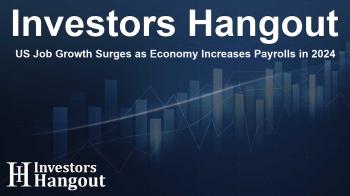US Job Growth Surges as Economy Increases Payrolls in 2024

US Job Growth Shows Resilience Amid Economic Changes
The U.S. labor market concluded with a remarkable report, witnessing an addition of 256,000 jobs in December. This impressive figure exceeded expectations set by economists and highlighted the ongoing strength of the U.S. economy.
Nonfarm payrolls surged from a revised rate of 212,000 in November, greatly surpassing predictions of 160,000 job additions. This notable growth reinforces confidence in the labor market's robustness.
Job Market Dynamics: A Closer Look
Unemployment Rate and Wages
The Bureau of Labor Statistics released data indicating not just an increase in jobs but also a decrease in the unemployment rate, which fell from 4.2% to 4.1%. This drop beat the forecasts that expected no change in the rate.
Meanwhile, average hourly earnings went up by 0.3% from the previous month. Although this figure matched expectations, it showed a slowdown from a 0.4% increase in November. On a year-over-year basis, wages increased by 3.9%, slightly below the anticipated 4% growth.
Key Industries Contributing to Job Gains
Sector Overview
December saw significant employment growth led by several key sectors, particularly health care, retail trade, and government jobs, while the leisure and hospitality sector experienced minor changes.
Health care saw substantial job growth, adding 46,000 jobs to the sector, which is part of an ongoing upward trend. Retail trade, recovering from previous losses, marked a notable gain of 43,000 jobs in December following a loss of 29,000 jobs in November.
Additionally, government employment contributed positively with 33,000 new positions, and social assistance services provided an extra 23,000 jobs, driven by ongoing demand for support services.
In contrast, the leisure and hospitality sector only saw a modest growth of 43,000 jobs, indicating more stability than volatility in this area.
Market Responses: Analyzing the Impact
Economic Reactions
The unexpectedly high job growth presents challenges for the Federal Reserve as it shapes its monetary policy roadmap. While a strong labor market could signal positive economic growth, it creates additional pressure on policymakers to address inflation, especially as recent price rises come back into focus.
Market reactions were swift; the yields on two-year Treasury bonds—which are particularly sensitive to interest rate fluctuations—increased by 11 basis points, reaching 4.38%. This uptick reflects concerns that the Federal Reserve may delay monetary easing until 2025 or later.
Following the report, the U.S. Dollar Index (DXY) rose by 0.3%, closely monitored by investors and traders. Futures tied to the S&P 500 indicated a cautious approach with a 0.6% decline in premarket trading.
Looking Forward: What to Expect
The employment report of December adds another layer of complexity to the current economic landscape as investors weigh the implications for future economic policy. The significant job growth along with wage trends will ultimately play a crucial role in shaping market responses and Federal Reserve initiatives moving forward.
Frequently Asked Questions
What does an addition of 256,000 jobs mean for the economy?
This significant job growth indicates a strong labor market, suggesting economic resilience and stability, which can positively impact consumer confidence and spending.
How does the unemployment rate affect the job market?
A decreasing unemployment rate signifies that more individuals are finding jobs, contributing to overall economic health and increased consumer purchasing power.
What sectors are driving recent employment growth?
Key sectors such as health care, retail trade, and government jobs have contributed significantly to employment growth in December, reflecting diverse economic activity.
How do market reactions influence economic policies?
Market reactions, reflected in changes in Treasury yields and currency strength, provide insights into investor sentiment, influencing policymakers at the Federal Reserve in their decision-making processes.
What can we expect from the Federal Reserve in response to strong job growth?
The Federal Reserve may adopt a hawkish stance in response to strong job growth to manage inflationary pressures, potentially delaying monetary easing measures in the near future.
About Investors Hangout
Investors Hangout is a leading online stock forum for financial discussion and learning, offering a wide range of free tools and resources. It draws in traders of all levels, who exchange market knowledge, investigate trading tactics, and keep an eye on industry developments in real time. Featuring financial articles, stock message boards, quotes, charts, company profiles, and live news updates. Through cooperative learning and a wealth of informational resources, it helps users from novices creating their first portfolios to experts honing their techniques. Join Investors Hangout today: https://investorshangout.com/
Disclaimer: The content of this article is solely for general informational purposes only; it does not represent legal, financial, or investment advice. Investors Hangout does not offer financial advice; the author is not a licensed financial advisor. Consult a qualified advisor before making any financial or investment decisions based on this article. The author's interpretation of publicly available data shapes the opinions presented here; as a result, they should not be taken as advice to purchase, sell, or hold any securities mentioned or any other investments. The author does not guarantee the accuracy, completeness, or timeliness of any material, providing it "as is." Information and market conditions may change; past performance is not indicative of future outcomes. If any of the material offered here is inaccurate, please contact us for corrections.
